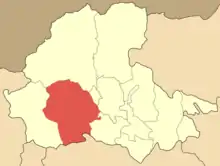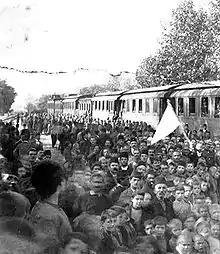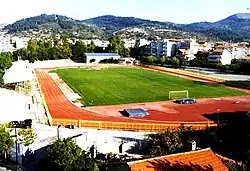Edessa, Greece
Edessa (Greek: Έδεσσα, pronounced [ˈeðesa]; also known as the "City of Waters and of the 5 Senses"),[2] until 1923 Vodena (Greek: Βοδενά), is a city in northern Greece and the capital of the Pella regional unit, in the Central Macedonia region of Greece. It was also the capital of the defunct province of the same name.
Edessa
Έδεσσα | |
|---|---|
.jpg.webp) Edessa's waterfalls, landmark of the town | |
 Edessa Location within the region  | |
| Coordinates: 40°48′N 22°3′E | |
| Country | Greece |
| Geographic region | Macedonia |
| Administrative region | Central Macedonia |
| Regional unit | Pella |
| Districts | 15 |
| Government | |
| • Mayor | Dimitris Giannou (ND; since 2011) |
| Area | |
| • Municipality | 611.212 km2 (235.990 sq mi) |
| • Municipal unit | 321.2 km2 (124.0 sq mi) |
| Elevation | 320 m (1,050 ft) |
| Population (2011)[1] | |
| • Total | 18,229 |
| • Municipality | 28,814 |
| • Municipality density | 47/km2 (120/sq mi) |
| • Municipal unit | 25,179 |
| • Municipal unit density | 78/km2 (200/sq mi) |
| Community | |
| • Population | 19,036 (2011) |
| Time zone | UTC+2 (EET) |
| • Summer (DST) | UTC+3 (EEST) |
| Postal code | 582 00 |
| Area code(s) | 23810 |
| Vehicle registration | ΕΕ |
| Website | dimosedessas.gov.gr |
Edessa holds a special place in the history of the Greek world as, according to some ancient sources, it was here that Caranus established the first capital of ancient Macedon.[3] Later, under the Byzantine Empire, Edessa benefited from its strategic location, controlling the Via Egnatia as it enters the Pindus mountains, and became a center of medieval Greek culture, famed for its strong walls and fortifications.[3] In the modern period, Edessa was one of Greece's industrial centers until the middle of the 20th century, with many textile factories operating in the city and its immediate vicinity. Today however its economy mainly relies on services and tourism. Edessa hosts most of the administrative services of the Pella regional unit, as well as some departments of the Thessaloniki-based University of Macedonia.[4]
Name
The Greek name Ἔδεσσα (Édessa) means "tower in the water"[3] and is generally thought to be of Phrygian origin,[5][6] although a minority of scholars consider it to be Illyrian instead.[7] The Slavic name Vodĭnŭ (Водьнъ) commonly held to derive from the Slavic word for "water"[8] was first attested in the 10th century, and became the common name until the 20th century.
Vodená (Βοδενά) was the name used in Greek until 1923, when the ancient name was revived.[9][10] The Bulgarian and Macedonian name remains Voden (Cyrillic: Воден). In Turkish, the city is known as Vodina, and in Aromanian the city is known as either Edessa, Vudena or Vodina.
Seleucus I Nicator named the city of Edessa in Mesopotamia (modern Şanlıurfa, Turkey) after the Macedonian Edessa.
Municipality
The municipality Edessa was formed at the 2011 local government reform by the merger of the following 2 former municipalities, that became municipal units:[11]
- Edessa
- Vegoritida
The municipality has an area of 611.212 km2, the municipal unit 321.225 km2.[12]
History
.jpg.webp)
According to some ancient writers, Caranus, the legendary founder of the Argead Dynasty (whose most famous member was Alexander the Great), established the city of Edessa and made it the first capital of ancient Macedon,[3] and later Argead rulers moved Macedon's capital to Aegae and eventually Pella. Archaeological remains have been discovered on the site of ancient Edessa, just below the modern city (40°47'48.48"N 22° 3'26.24"E). The walls and many buildings have been unearthed so far. A colonnade with inscription in Greek dates from Roman times. The city achieved certain prominence in the first centuries AD, being located on the Via Egnatia. From 27 BC to 268 AD it had its own mint. The Orthodox Christian Saint Vassa and her three children were put to death here in the 3rd century AD.[13][14]
 | |
| O: laureate draped and cuirassed bust | R: Roma seated on shield holding Nike with wreath and palm and parazonium is crowned with a wreath by Tyche holding cornucopia standing behind
ΕΔΕϹϹΑΙΩΝ / ΟΜΟΝΟΙ / Α |
| bronze coin struck by Philip the Arab in Edessa 244-249 AD; ref.: Moushmov 6277 Plate XLIV 21 | |
Little is known about the fate of the city after 500 AD, but we know that its Greek bishop, Isidoros, participated in the Ecumenical Council of 692.
The city disappears from the sources thereafter, and re-emerges only in the 11th century, in the account of the Bulgarian wars of Emperor Basil II by the chronicler John Skylitzes, with the Slavic name Vodena (τὰ Βοδηνά in Greek).[15] The Bulgarian historian Vasil Zlatarski hypothesized that it was Vodena, and not Vidin on the Danube, that was a base of the Cometopuli in their revolt against Byzantium.[15]
Due to its strategic location, controlling the Via Egnatia as it enters the Pindus mountains, the town was much fought over in the subsequent centuries: the Normans under Bohemond I captured it briefly in 1083, but were eventually repelled by the forces of Emperor Alexios I Komnenos. The Nicaean emperor John III Vatatzes captured in 1253, while in the mid-14th century its possession was disputed between the Byzantines and the Serbs under Stephen Dushan, with the latter securing its possession in January 1351.[15] The city was for some time under control of Radoslav Hlapen, who gave it as dowry to his son-in-law Nikola Bagaš probably around 1366/7.[16] The city remained in Bagaš's hands at least until 1385.[17] It was conquered by the Ottoman commander Evrenos Bey in the late 14th century, along with the rest of Macedonia.[15] In 1519 (Hijri 925) the town had 68 Muslim and 116 Christian households; it was a joint zeamet of Murad of İpek, and Hüseyin the son of dizdar.[18]
During the period of Ottoman rule, the Turkish and Muslim component of the town's population steadily increased. From the 1860s onwards, the town was a flashpoint for clashes between Greeks and Bulgarians.[19]
_sur_la_route_de_Monastir.jpg.webp)
After almost 500 years of Ottoman rule, Edessa was annexed by Greece on 18 October 1912 during the First Balkan War, following the Hellenic Army's military victory against the Ottomans in the battle of Sarantaporo. At that time, Edessa was already well on its way to becoming a major industrial center in Macedonia. Four large textile factories with the Hemp Factory[20] being the biggest, employing the abundant waterfalls as a source of energy. Prior to World War I, in addition to Greeks, the region of Edessa was also populated by Turks, Bulgarians, Pomaks and Vlachs, but during the population exchange between Greece and Turkey most of the Turks and Pomaks living in Edessa were transferred to Turkey. Large numbers of Greek refugees from Asia Minor were settled in the area in 1923. The population swelled from 9,441 to 13,115 in the 1920s. A large segment of the population specialized in silk production, allowing Edessa to enjoy a high standard of living in the interwar period (1922–1940).
The town suffered during the last days of German occupation of Greece in 1944. As a retaliation for the shooting of one soldier by resistance fighters, the Nazis set Edessa on fire. Half of the city, including the Cathedral and the First Primary School, was destroyed and thousands of people were left homeless.
During the Greek Civil War (1946-1949) Edessa was twice attacked in 1948 by the Democratic Army of Greece (DSE), under the control of the Communist Party of Greece. The Slavic-Macedonian National Liberation Front (SNOF), later simply the National Liberation Front (NOF) was heavily established in the area, with eleven Slav Macedonian partisan units operating in the mountains around the city.[21][22] When the NOF merged with the Democratic Army of Greece (DSE), many Slav Macedonians in the region enlisted as volunteers in the DSE.[23] In early 1949, the military forces of the Greek Government conducted a series of successful military operations that destroyed all communist forces and after the end of war in August 1949, many communists and sympathizers, both ethnic Greeks and Slav Macedonians were expelled from Greece and fled to the countries of Eastern Europe.[24]
Since the 1970s Edessa's economy no longer relies on industry. At the beginning of the 21st century, it is a city based on services (mostly linked to its function as capital of the Pella regional unit) and tourism due to the many ancient sights nearby, including ancient Pella, the waterfalls and winter sports.
The ancient site (Loggos)
.jpg.webp)
.jpg.webp)
Demographics

| Historical populations | |||
|---|---|---|---|
| (Statistics, 1913-2001) | |||
| Year | Town | Municipal unit | Municipality |
| 1913 | 8,846 | - | - |
| 1920 | 9,441 | - | - |
| 1928 | 13,115 | - | - |
| 1940 | 12,000[25] | - | - |
| 1951 | 14,940 | - | - |
| 1961 | 15,534 | - | - |
| 1971 | 13,967 | - | - |
| 1981 | 16,642 | - | - |
| 1991 | 17,659 | 25,051 | - |
| 2001 | 18,253 | 25,619 | - |
| 2011 | 19,036 | 25,179 | 28,814 |
Infrastructure

Transportation

Edessa railway station is located on the Thessaloniki–Bitola railway and is served by both InterCity trains and Proastiakos Thessaloniki suburban trains.
Media
- Pella TV
- Egnatia TV
Sports
Edessa hosts two sport clubs with presence or earlier presence in the higher national divisions in Greek football and handball. These clubs are shown below.
| Sport clubs based in Edessa | |||
|---|---|---|---|
| Club | Founded | Sports | Achievements |
| Edessaikos F.C. | 1959 | Football | Earlier presence in A Ethniki |
| Aeropos Edessas | 1978 | Handball | Presence in A1 Ethniki handball |
Notable people
- Minas Minoidis (18th century), scholar, figure of the Modern Greek Enlightenment
- Solon Grigoriadis (1912-1994), army officer and journalist
- Dimitris Beis (1928 - 2012) resistance figure against the junta of the Colonels and Mayor of Athens, 1979 - 1986
- Giorgos Paschalidis, (born 1951) former Minister and close associate of Prime Minister Costas Simitis
- Aggelis Gatsos[26] (1771–1839), fighter in the Greek War of Independence
- Vangel Ajanovski-Oče (1909–1996), Ethnic Macedonian secretary of SNOF
- Hakkı Yeten (1910-1989), famous Turkish Football Player of Beşiktaş J.K.
- Hadži-Neimar (1792-1870), architect and chief builder of the autonomous Principality of Serbia
- Markos Meskos, writer, poet
- Marietta Chrousala (born 1983 ), fashion model and television presenter
Twin cities
Gallery
 View of the area
View of the area Crowd celebrating the liberation of Edessa (First Balkan War)
Crowd celebrating the liberation of Edessa (First Balkan War) A statue of Alexander the Great
A statue of Alexander the Great View of the old Kanavourgeio (cannabis factory)
View of the old Kanavourgeio (cannabis factory) Folklore museum
Folklore museum Dormition of Theotokos (14th)
Dormition of Theotokos (14th) Interior
Interior Municipal stadium
Municipal stadium
See also
References
- "Απογραφή Πληθυσμού - Κατοικιών 2011. ΜΟΝΙΜΟΣ Πληθυσμός" (in Greek). Hellenic Statistical Authority.
- "Edessa city of waters. Pella - Macedonia - Greece. Waterfalls, Agios Athanasios, Kaimaktsalan. Εδεσσα, Πέλλα, Μακεδονία, Ελλάδα. Καταρράκτες, Αγιος Αθανάσιος, Καιμάκτσαλάν". www.edessacity.gr. Retrieved 2021-08-16.
- "Pellanet - Καθημερινή ενημέρωση".
- "Edessa - Tourism".
- N.G.L. Hammond, "The Literary Tradition for the Migrations", in The Cambridge Ancient History II.2B:710 1975
- Hammond N.G.L, A history of Macedonia, Historical geography and prehistory, Vol. 1, Oxford 1979
- Ulrich Wilcken, Alexander the Great, p. 23
- Chisholm, Hugh, ed. (1911). . Encyclopædia Britannica. Vol. 28 (11th ed.). Cambridge University Press. p. 170.
- Paul Hellander, Greece, Lonely Planet, 2008, p. 302
- cf. Geographical name changes in Greece
- "ΦΕΚ A 87/2010, Kallikratis reform law text" (in Greek). Government Gazette.
- "Population & housing census 2001 (incl. area and average elevation)" (PDF) (in Greek). National Statistical Service of Greece. Archived from the original (PDF) on 2015-09-21.
- "Antiochian Orthodox Christian Archdiocese of North America". www.antiochian.org. Retrieved 24 October 2014.
- Poulos, Fr. George. Orthodox Saints: Spiritual Profiles for Modern Man Vol. 3. 2005. Holy Cross Orthodox Press, ISBN 9780917651663
- Browning, Robert; Kazhdan, Alexander (1991). "Vodena". In Kazhdan, Alexander (ed.). The Oxford Dictionary of Byzantium. Oxford and New York: Oxford University Press. p. 2185. ISBN 978-0-19-504652-6.
- Зборник радова Византолошког института. Научно дело. 1987. p. 219.
... свакако пре 1366/7 ...указана је могућност да га је Хлапен одмах након тога уступио Николи Багашу, ожењеном једном од његвих кћери..
- Зборник радова Византолошког института. Научно дело. 1987. p. 164.
- GÖKBİLGİN, M. TAYYİB (1956). "KANUNÎ SULTAN SÜLEYMAN DEVRİ BAŞLARINDA RUMELİ EYALETİ, LİVALARI, ŞEHİR VE KASABALARI". Belleten. 20 (78): 264. eISSN 2791-6472. ISSN 0041-4255.
- Vacalopulos, Konstandinos A. Modern history of Macedonia, Thessaloniki 1988, p. 52, 57, 64
- "Old Hemp of Edessa (Artspace Culture & Industrial Museum)". youingreece.com. Retrieved 2018-10-20.
- "Les Archives de la Macedoine, Fond: Aegean Macedonia in NLW" - (Field report of Mihail Keramidzhiev to the Main Command of NOF), 8 July 1945
- Simpson, Neil (1994). Macedonia Its Disputed History. Victoria: Aristoc Press, 105,106 & 94. ISBN 0-646-20462-9.
- Η Τραγική αναμέτρηση, 1945-1949 – Ο μύθος και η αλήθεια. Ζαούσης Αλέξανδρος" (ISBN 9607213432).
- Simpson, Neil (1994). Macedonia Its Disputed History. Victoria: Aristoc Press, 101,102 & 91. ISBN 0-646-20462-9.
- "Edessa - 3000 years history". Edessacity.gr. Retrieved 2013-03-26.
- Επίτομο Γεωγραφικό Λεξικό της Ελλάδος (Geographical Dictionary of Greece), Μιχαήλ Σταματελάτος, Φωτεινή Βάμβα-Σταματελάτου, εκδ. Ερμής, ΑΘήνα 2001
Further reading
- F. Papazoglou, Les villes de Macédoine romaine (The Cities of Roman Macedonia), BCH Suppl. 16, 1988, 127–131.
- Walter Bauer, Orthodoxy and Heresy in Earliest Christianity, 1934, (in English 1971) (On-line text)

